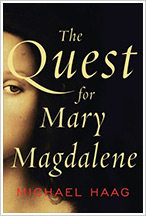The Quest for Mary Magdalene
By Michael Haag
Review By Casey Fedde
Categories: Bible Study, Biography/Memoir, Easter (Passion Week), Inspirational People, Women in the Bible Historian and writer Michael Haag explores the mysterious figure known as Mary Magdalene, tracing her story through the centuries from her presence in the canonical and gnostic gospels to her identity as a modern feminist icon. "The Quest for Mary Magdalene" is a tour de force!
 The first half of "The Quest" is dedicated to Mary Magdalene's cameos in the gospels of the New Testament – the books of Matthew, Mark, Luke, and John. It's here in these biblical books that we learn that she was one of the women who traveled with Jesus around Galilee. Together, the canonical gospels mold Mary Magdalene into "the woman who knew Jesus" (7). The first half of "The Quest" is dedicated to Mary Magdalene's cameos in the gospels of the New Testament – the books of Matthew, Mark, Luke, and John. It's here in these biblical books that we learn that she was one of the women who traveled with Jesus around Galilee. Together, the canonical gospels mold Mary Magdalene into "the woman who knew Jesus" (7).
But even as one of Jesus' groupies, Haag says, there are a lot of uncertainties and inconsistencies regarding her whereabouts and actions. The appearance of an "unnamed woman" complicates matters as well. In fact, one of the few details on which the gospels agree is her presence at Jesus' tomb. She "was always there – which suggests that Mary Magdalene at the empty tomb was an event well known to the followers of Jesus and to the earliest Christians; she was central to the story, though the truth of the story was obscured or lost..." (133).
In the gospels, Mary Magdalene speaks only two times, and she isn't mentioned elsewhere in the New Testament. Haag writes, "Before there were gospels, before there was anything written about Jesus or Mary Magdalene, there was Paul.... Paul has a reputation for misogyny but would this be enough for his failure to mention Mary Magdalene?... It scarcely seems possible that during his visits to Jerusalem Paul did not meet Mary Magdalene or at least hear of her" (165-166). Haag sifts through the letters of Paul – briefly tail-spinning through somewhat related Egyptian religious practices, rituals, and beliefs. Unfortunately, these tangents are all too common throughout "The Quest," and while informative, they pile too much on a casual reader. Nevertheless, the quest for her identity expands.
Haag delves into the gnostic gospels, the codices found at Nag Hammadi that comprise 52 treatises dating to the 3rd and 4th centuries AD, and reveals what they teach us about our mystery woman. In these codices, Haag says, "Mary Magdalene appears as something of a device, asking and answering questions, but then the gnostic gospels are like that. They lack the narrative and characterization of the canonical gospels which have the feel of being rooted in the everyday..." (214-215). It is the discovery of these codices, Haag says, that sparks the fascination of Mary Magdalene. In the Gospel of Philip, for example, Mary Magdalene is intimately involved with Jesus, her husband. And who doesn't love a good love story?
It is at this point, after the gnostics, that the assault on Mary Magdalene surfaces, and her roles shift. Haag meanders through the legends of the Middle Ages, the 1,400-year papal rumor that Mary Magdalene was a prostitute, the shrines erected to honor the "Apostle of the Apostles" who preached Jesus' resurrection to those who doubted, and the artwork and books characterizing her. (Haag includes the artwork and other pictures throughout "The Quest," offering yet another dimension to Mary Magdalene.)
Finally, we have a complete picture of Mary Magdalene – or do we? Haag is an astute scholar, and his profile of such a complex woman shines, especially in the early chapters. But Mary Magdalene is truly larger than any text, he says. So even the best seeker on a quest for truth cannot do her full justice. |